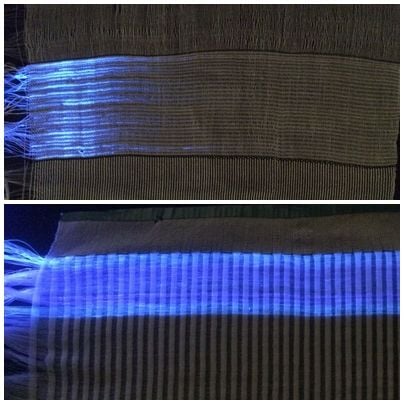These Light-Emitting Pajamas Could Help Treat Newborns With Jaundice
The method has an advantage over traditional phototherapy in that it allows babies to receive treatment in the comfort of their parents’ arms
/https://tf-cmsv2-smithsonianmag-media.s3.amazonaws.com/filer/b1/f6/b1f6e897-b372-440f-9e61-798abbd22e0c/babypyjama_puppe_doll.jpg)
Watching a tiny baby undergo jaundice treatment alone in the blue glow of a bassinet can be tough on parents, who want to spend those first days holding their little bundle. And yet it’s common. Jaundice, the yellowness caused by the buildup of the bile pigment bilirubin in the blood, affects about 60 percent of newborns, and about 5 to 10 percent have jaundice serious enough to necessitate phototherapy.
Now, Swiss researchers have come up with what they hope may be a better approach to phototherapy than the traditional bassinet-with-lights. They’ve developed textiles woven through with optically conductive fibers. Using battery-operated LEDs as a light source, the fibers distribute light evenly through the fabric. The fabric can be sewn into pajamas or a sleep sack for babies, allowing them to receive treatment while being cuddled by caregivers.
“Currently, newborn babies need to stay naked under strong blue light, with eye protection, and away from their mothers,” says Luciano Boesel, a textile scientist at the Swiss Federal Laboratories for Materials Science and Technology. “We wanted to develop a portable textile system that babies could use, so that the treatment could eventually even be performed at home, together with their parents.”
The research was recently published in the journal Biomedical Optics Express.
While jaundice is common, if left untreated it can cause a type of brain damage known as kernicterus, which can leave babies with hearing loss and developmental disabilities. Rarely, it can even cause death. The most common treatment in the developed world is to keep the jaundiced infant in a bassinet wearing nothing but a diaper and a pair of protective sunglasses beneath lights in the blue-green spectrum. This color of light is easily absorbed by the skin, where it breaks down bilirubin into products that can be easily excreted. The length of treatment can vary from less than a day to a week or more. Sometimes the overhead light treatment is combined with a “bili blanket,” a pad with fiberoptic lights that the baby lies on. In milder cases of jaundice, these bili blankets are sometimes all that’s necessary.

The new textile is an improvement over previous treatments in that it’s breathable, washable, and can be worn directly next to the baby’s skin, Boesel says. The team found that the weaving process that produced the best result in terms of light penetration is the process that produces satin. In the satin weave, the optical threads don’t cross with the traditional thread very often, which maximizes light available to be emitted over the skin. It also makes the fabric quite soft. The fabric can be sewn into pajamas where the light-emitting part faces in, so no light is shining towards the baby’s eyes, meaning there’s no need for sunglasses.
When treating jaundice, it’s important to expose as much of a baby's skin to light as possible, says Tina Slusher, a pediatrician at the University of Minnesota who studies jaundice.
“[The jaundice pajamas] sound like a cool idea,” Slusher says. “More surface area would be covered, and of course that’s a huge part of treating jaundice.”
Slusher says it’s fairly rare for jaundice to become serious in the developed world. But in places where hospitals are underfunded or where electricity for phototherapy is not reliable, babies can and do get very sick and die.
“It’s a really, really, really bad disease,” she says.
Slusher has been involved in work on electricity-free sunlight-filtering canopies that use plastic films to allow only the blue wavelengths of light through. Sunlight is the oldest treatment for jaundice, used since the 1950s, when a British nurse noticed that jaundiced babies improved after being outdoors. But direct sunlight is not safe for newborns, who have delicate skin and difficulty regulating their body temperatures.
Boesel and his team have developed a prototype of their textiles and hope to find industrial partners to turn it into a commercial product. He estimates this will take a year or two. In the meantime the team is talking with Swiss hospitals interested in doing studies with the prototype.
So perhaps in a few years jaundiced newborns will no longer have to don tiny sunglasses, and can instead sleep snugly in glowing satin suits.
/https://tf-cmsv2-smithsonianmag-media.s3.amazonaws.com/accounts/headshot/matchar.png)
/https://tf-cmsv2-smithsonianmag-media.s3.amazonaws.com/accounts/headshot/matchar.png)